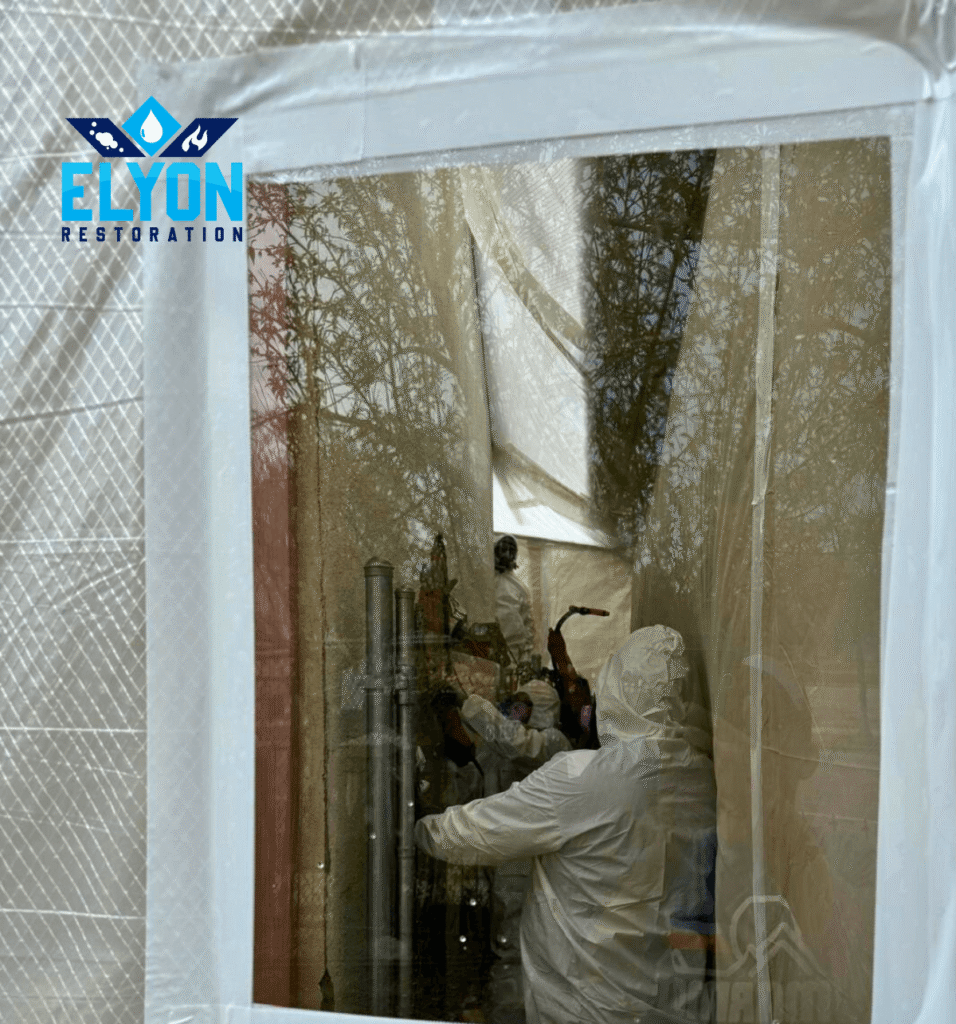Frequently Asked Questions
How long does asbestos abatement take in Denver?
The duration of asbestos abatement in Denver varies based on factors such as the size of the area and the complexity of the job. Typically, the process can take a few days to a week to complete safely and effectively.
What are the costs of asbestos abatement services?
The costs of asbestos abatement services vary based on factors such as the size of the area, the extent of contamination, and the specific techniques used. For an accurate estimate, it's best to schedule a consultation with Elyon Restoration.
How to find certified asbestos abatement contractors?
Finding certified asbestos abatement contractors involves researching local professionals who hold the necessary licenses and certifications. Check online directories, read reviews, and verify qualifications to ensure safe and effective asbestos removal services.
What is the process of asbestos abatement services?
The process of asbestos abatement services involves several key steps: initial inspection and testing, containment of the area, safe removal of asbestos materials, thorough cleanup, and final air quality testing to ensure safety before reoccupying the space.
Do I need a permit for asbestos removal in Denver?
In Denver, a permit is required for asbestos removal to ensure compliance with safety regulations. It is essential to consult with a licensed asbestos abatement contractor to navigate the permitting process effectively.
Do I need a permit for asbestos abatement in Denver?
A permit is required for asbestos abatement in Denver to ensure compliance with safety regulations. It is essential to consult with local authorities or a licensed professional for guidance on the permitting process.
Is asbestos abatement necessary for old Denver buildings?
Asbestos abatement is essential for old Denver buildings due to the health risks associated with asbestos exposure. Many older structures contain asbestos materials that can pose serious hazards if disturbed, making professional removal crucial for safety.
What is the cost of asbestos abatement in Denver?
The cost of asbestos abatement in Denver varies based on factors like the size of the area, the extent of contamination, and specific materials involved. Typically, homeowners can expect prices to range from $1,500 to $3,000 or more.
How long does asbestos removal take in Denver?
The duration of asbestos removal in Denver varies based on the project size and complexity. Typically, it can take anywhere from a few hours to several days to complete the process safely and thoroughly.
How do I find asbestos abatement contractors in Denver?
Finding asbestos abatement contractors in Denver involves researching local companies, checking online reviews, and verifying their certifications. You can also ask for recommendations from friends or professionals in the construction industry to ensure you choose a reliable service.
What are the costs of asbestos removal in Denver?
The costs of asbestos removal in Denver vary based on factors such as the extent of contamination and the type of materials involved. Typically, prices range from $1,500 to $3,000 for residential properties, but a detailed inspection is necessary for an accurate estimate.
Who regulates asbestos removal in Denver, Colorado?
The regulation of asbestos removal in Denver, Colorado, is overseen by the Colorado Department of Public Health and Environment (CDPHE) and the Environmental Protection Agency (EPA), ensuring compliance with safety standards and proper handling of asbestos materials.
What are the EPA regulations for asbestos abatement in Denver?
The EPA regulations for asbestos abatement in Denver require compliance with specific guidelines to ensure safe handling and removal of asbestos materials, including proper notification, containment, and disposal procedures to protect public health and the environment.
What are the benefits of asbestos abatement services?
The benefits of asbestos abatement services include the elimination of health risks associated with asbestos exposure, improved indoor air quality, and enhanced property value. These services ensure a safe environment for occupants and comply with regulatory standards.
What qualifications should asbestos abatement contractors have?
The qualifications that asbestos abatement contractors should have include proper licensing, certifications in asbestos handling and removal, and experience in the field. Additionally, they should follow safety regulations and best practices to ensure effective and safe remediation.
How to verify asbestos abatement contractor credentials?
Verifying asbestos abatement contractor credentials involves checking for proper licensing, certifications, and insurance. Ensure they comply with local regulations and review their experience and customer references to confirm their reliability and expertise in safe asbestos removal.
What safety measures are taken during abatement?
The safety measures taken during abatement include using personal protective equipment (PPE), establishing containment areas, employing negative air pressure systems, and conducting thorough air quality monitoring to prevent asbestos exposure and ensure a safe environment.
How to prepare for asbestos abatement services?
Preparing for asbestos abatement services involves ensuring the work area is clear of furniture and personal items, securing pets, and informing residents of the scheduled removal to minimize exposure and disruptions.
What types of buildings require asbestos abatement?
The types of buildings that require asbestos abatement include older homes, schools, commercial buildings, and industrial facilities constructed before the 1980s, as they are more likely to contain asbestos-containing materials.
How often should asbestos inspections be conducted?
Asbestos inspections should be conducted regularly, ideally every 1 to 3 years, especially in older buildings or if renovations are planned. Frequent inspections help ensure safety by identifying any potential asbestos risks early.
What are the signs of asbestos in buildings?
The signs of asbestos in buildings include the presence of materials such as textured ceilings, insulation, floor tiles, and pipe coverings manufactured before the 1980s, which may contain asbestos fibers.
What is the timeline for asbestos removal projects?
The timeline for asbestos removal projects varies based on the size and complexity of the job. Typically, the process can take anywhere from a few days to several weeks, including inspection, planning, and actual removal.
How to choose the right abatement service?
Choosing the right abatement service involves evaluating their experience, certifications, and safety protocols. Look for companies with positive reviews, transparent pricing, and a comprehensive approach to asbestos removal to ensure effective and safe remediation.
What are the long-term effects of asbestos exposure?
The long-term effects of asbestos exposure include serious health issues such as asbestosis, lung cancer, and mesothelioma, which can develop many years after initial exposure, leading to significant respiratory and overall health complications.
What should I expect during the abatement process?
During the abatement process, you can expect a thorough inspection, containment of affected areas, safe removal of asbestos materials, and final clearance testing to ensure safety before reoccupation.
Are there any financial assistance programs for abatement?
Financial assistance programs for asbestos abatement are available through various local and federal agencies. These programs can help homeowners cover the costs associated with safe asbestos removal, ensuring a healthier living environment.
What materials are commonly associated with asbestos?
Common materials associated with asbestos include insulation, roofing shingles, floor tiles, ceiling tiles, and textured paints. These products often contained asbestos fibers due to their fire-resistant properties, posing health risks when disturbed.
How does weather affect asbestos abatement procedures?
Weather can significantly impact asbestos abatement procedures. Extreme temperatures, high humidity, or precipitation can hinder the safe removal process, potentially leading to increased risks of exposure and affecting the efficiency of containment measures.
What happens if asbestos is disturbed during renovation?
Disturbing asbestos during renovation can release harmful fibers into the air, posing serious health risks such as lung disease and cancer. It is crucial to have professional asbestos abatement services in place to safely manage and remove any asbestos materials before starting renovation work.
What training do abatement professionals undergo?
Abatement professionals undergo specialized training that includes safety protocols, asbestos identification, removal techniques, and regulatory compliance to ensure effective and safe handling of hazardous materials. This training is essential for protecting both workers and the public.



